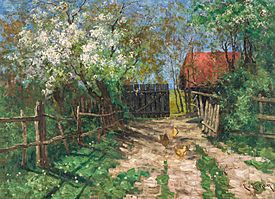Elisabeth von Eicken facts for kids
Quick facts for kids
Elisabeth von Eicken
|
|
|---|---|

Frühling (Spring)
|
|
| Born | 18 July 1862 |
| Died | 21 July 1940 (aged 78) |
| Occupation | landscape painter |
| Spouse(s) | Henry Edler von Paepke |
Elisabeth von Eicken (born July 18, 1862 – died July 21, 1940) was a talented German landscape painter. She was known for her beautiful paintings of nature, especially forests and countryside scenes. Elisabeth was an important artist who helped start an artists' colony in Ahrenshoop, a special place where many artists lived and worked together.
Contents
Life of Elisabeth von Eicken
Elisabeth von Eicken was born in Mülheim an der Ruhr, Germany. She was the third daughter of Hermann Wilhelm von Eicken and Anna Elisabeth Borchers. From 1871 to 1878, she attended the "Luisenschule" in her hometown.
Artistic Training and Influences
Elisabeth studied art in several cities, including Merano, Menton, Geneva, and Berlin. She then continued her training in Paris with a teacher named Edmond Yon. During this time, her landscape paintings were greatly influenced by two important art movements:
- The Barbizon School: This was a group of French artists who painted landscapes directly from nature, often showing rural life.
- Alfred Sisley: He was a famous Impressionist painter known for his beautiful landscape paintings.
Life as a Professional Artist
From 1894, Elisabeth von Eicken worked as a freelance artist. This means she worked for herself and sold her own paintings. She spent her time in two main places:
- Ahrenshoop: This was a special place where many artists lived and worked together, known as an artists' colony. In 1894, Elisabeth built her own house there. She became good friends with the artists who started the colony, like Paul Müller-Kaempff and Anna Gerresheim.
- Berlin-Grunewald: This was a part of Berlin where she also had a studio.
Elisabeth's work was shown regularly at the Great Berlin Art Exhibition starting in 1894. Her paintings were also displayed at international art shows in places like Munich, Paris, and St Louis in the United States. She was a member of important art groups, including the Association of Berlin Woman Artists.
In 1895, Elisabeth married Henry Edler von Paepke. He was the lord of the manor of Quassel, a large estate near Lübtheen in Mecklenburg.
Selected Works by Elisabeth von Eicken
Elisabeth von Eicken created many beautiful landscape paintings throughout her career. Here are some examples of her works that were shown at the Great Berlin Art Exhibition:
- 1894: Waldeinsamkeit (Forest Loneliness); Aus der Picardie (From the Picardy); Regenstimmung – in Ahrenshoop (Rain mood)
- 1895: Bauernhof in Mecklenburg (Farm); Die letzten Blätter (The last Leaves); Tannenwald (Forest Firs)
- 1896: Wenn die Natur zur Ruhe geht (When nature comes to rest); Unser deutscher Wald (Our German Forest); Waldeszauber (Forest Magic)
- 1897: Herbst im Walde (Autumn in the Forest); Auf der InseI Bornholm (On the Bornholm island); Das Geheimnis des Waldes (The secret of the forest)
- 1898: Octobermorgen im Walde (October Morning in the Forest); Im Spätherbst (Later Autumn)
- 1899: Im Schutz der Dünen (Under the protection of Dunes); Herbst-Eiche (Autumn-Oak)
- 1901: Waldeinsamkeit (Forest Loneliness); Herbstgedanken (Autumn Thoughts)
- 1902: Im Dorf (In the Village)
- 1903: Im tiefen Schweigen liegt die Natur (The Nature is in deep Silence)
- 1904: Grenshooyer Friedhof (Cemetery)
- 1906: Ein stiller Winkel (A silent Corner)
- 1910: Stille am Bach (Silence on the Creek)
- 1912: Waldbach (Forest Creek)
See also
 In Spanish: Elisabeth von Eicken para niños
In Spanish: Elisabeth von Eicken para niños
- List of German women artists


